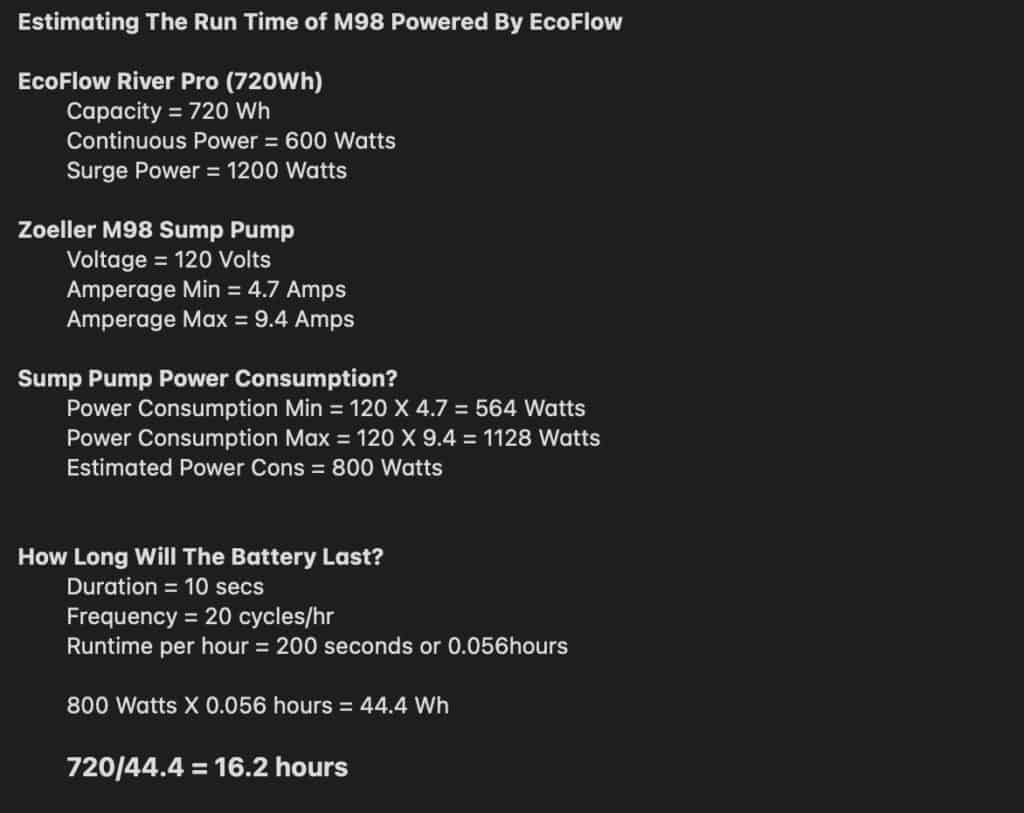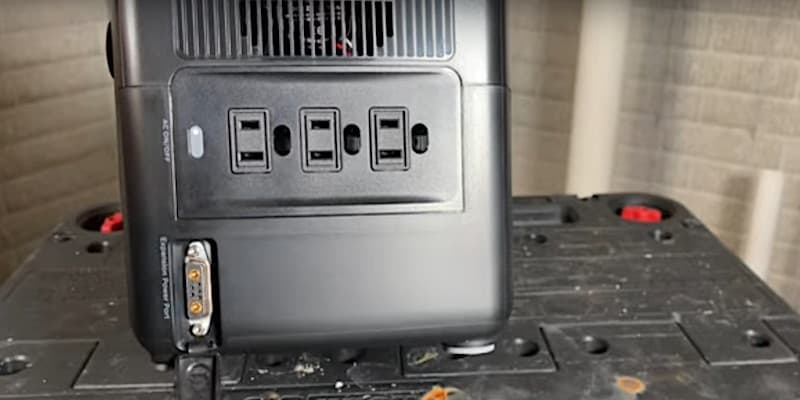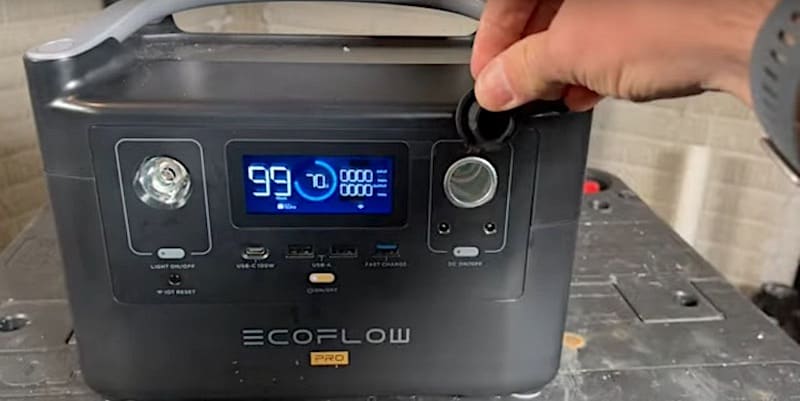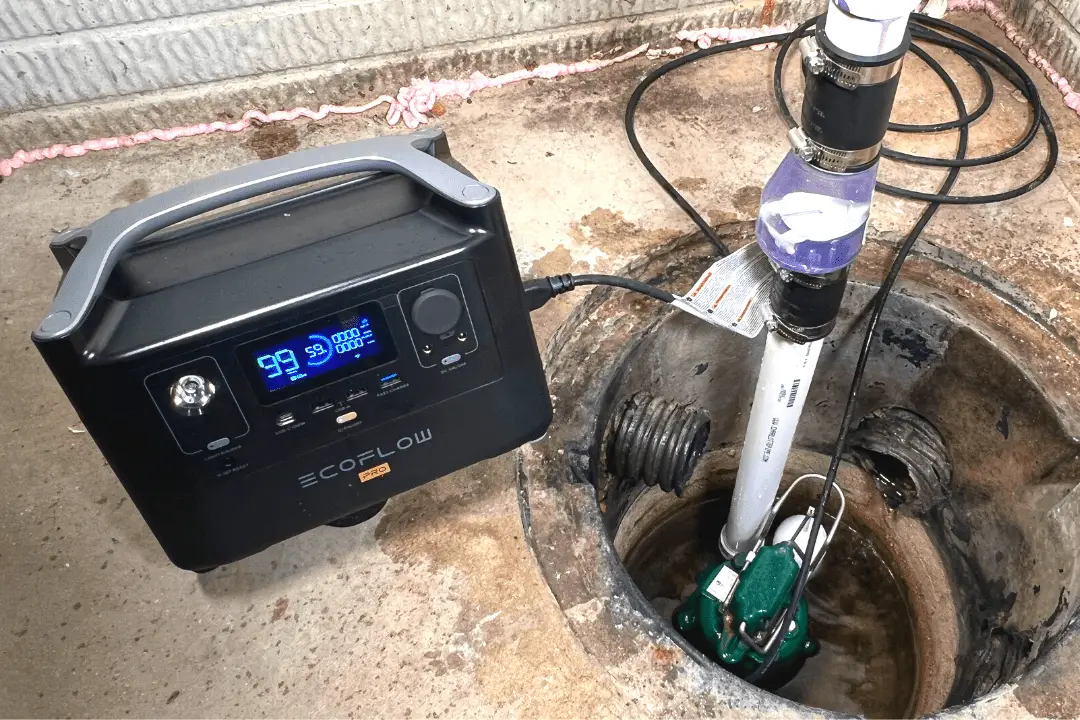The use of a portable power station as a backup power source for a sump pump is the subject of today’s tutorial.
I purchased the Ecoflow River Pro portable power station on Amazon for use on camping trips and at the job site to power up our battery packs, but more importantly, I wanted it for the crucial job of being a battery backup for my sump pump.
I want to see if the Ecoflow can actually provide the power needed to run my sump pump, and how long it would last if the power stayed off for a prolonged period.
Calculating How Long a Portable Power Station Will Run a Sump Pump: Step-by-Step Guide
In this step-by-step guide, I’ll run you through how I did the calculations to determine if the Ecoflow River Pro portable power station can run a sump pump, as well as how long it would last as a backup power source. You’ll need to do a little arithmetic to make sure that this or any other portable power station is right for your application — whether you’re powering a sump pump, a refrigerator, or any other appliance or piece of equipment you rely on critically.
After we do the math, I’ll show you some of the features of the Ecoflow River Pro, and then we’ll do some testing. We’re going to run the sump pump on the power station for a fair number of hours to validate my calculations for how long the Ecoflow River pro will run my Sump Pump. This will tell us if it’s a good backup solution or not.
Rather watch than read? Check out this 12-minute video.
DISCLAIMER: This video and description contain affiliate links, which means that if you click on one of the product links, I’ll receive a small commission.
Calculating How Long a Portable Power Station Will Run a Sump Pump: Supplies, Tools, and Costs
Supplies
Ecoflow River Pro portable power station
Tools
No tools needed for this tutorial, but a calculator will come in handy.
To see all my favorite tools, check out our Amazon store.
Can a Portable Power Station Run a Sump Pump? How to Calculate
To do the calculations, you’ll need the specifications of your portable power unit and whatever you’re looking to provide power to. In my case, the power unit is the Ecoflow River Pro 720 Wh and the object I’m powering is a Zoeller M98 sump pump.
Looking at the stats I’ve compiled below, we know the capacity of our Ecoflow River Pro battery is 720 Wh of continuous power. It can deliver 600 watts with a surge of 1200 or even a bit above that thanks to a boost feature.

The sump pump runs on 120 volts. It has a minimum amperage draw of 4.7 amps and a max of 9.4 amps.
Keep in mind that the amperage will change depending on how far the pump needs to vertically push water. In my situation, it’s going to push water up about 8 feet. Seeing that the maximum delivery of the pump is 23 feet, I know I’m not going to be even close to approaching 9.4 amps.
Let’s look at the power consumption because my first question is “Can this portable power unit provide enough power?”
With this question in mind, I converted the minimum amperage of my unit into watts:
- 120 volts x 4.7 amps (minimum amps) = 564 watts
On the high side, I’ll use the same formula, substituting the max amps of my power station:
- 120 volts x 9.4 amps (maximum amps) = 1128 watts
To estimate my consumption, I’d say it’s going to be around 800 watts, which is about the halfway point between my high and low because I’m not using the full capacity of this pump. Having said that, 800 watts is more than the 600-watt continuous power rating of the power station. What makes me confident that the unit can handle 800 watts is the 1200-watt surge capacity. Taking that into consideration, I feel pretty confident that this Ecoflow can power my sump pump.
How Long Can a Portable Power Station Run my Sump Pump? How to Calculate
Now to address the question of how long the juice from the power station will last. We’ll need to figure out a few other factors for this calculation.
Calculating the Battery Life with Continuously-Running Equipment
Before we do that, let’s look at an example of a simpler use case. If the object you want to plug into a portable power unit is something that runs continuously at 800 watts, then the calculation is pretty straightforward:
- (continuous power capacity of unit in Wh) ÷ (power needed in W) = duration
- 720 Wh (continuous power capacity of Ecoflow) ÷ 800 W (power needed) = 0.9 hrs (54 minutes)
So if my sump pump were running all the time, the power station would power it for 54 minutes, but that’s not how sump pumps work. A sump pump usually comes on for intermittent, brief periods.
Calculating the Consumption of the Sump Pump (Intermittent Activity)
In order to calculate how long the power station will run my sump pump, I need an accurate estimate of the pump’s consumption, so I need to clock how long it usually runs and how frequently.
The time it takes to go from the high water mark, where the pump starts running, to the low water mark, where it turns off, is about 10 seconds.
Regarding frequency, right now it’s spring and the pump is running quite often because we’re getting some rain. With a little observation, I see that the pump is giving me about 20 cycles per hour.
With 20 cycles per hour at 10 seconds per cycle, my pump is running about 200 seconds out of every hour.
To get this pump running time as a percent of an hour:
- (total time in seconds my pump runs in an hour) ÷ (number of seconds in an hour)
- 200 seconds ÷ 3600 seconds/hr = 0.056 hrs
Now that I know what percentage of each hour the pump is actually running, I can calculate my hourly power consumption:
- (pump running time as % of each hour) x (estimated power needed) = watts/hr of consumption
- 0.056 hrs x 800 W = 44.4 watts/hr of consumption
Calculating the Battery Life with the Sump Pump
The last step in calculating how long the power station will run my sump pump is to divide the capacity of the power station by my consumption:
- (continuous power capacity of power station) ÷ (estimated consumption/hr) = hours of power
- 720 Wh ÷ 44.4 watts/hr = 16.2 hours
You can take this exact same approach and fit it to your situation, figuring out how long your sump pump runs during each cycle and how frequently, then doing the calculations using the specs from your power station.
Now that I’ve calculated this 16.2 hours of estimated battery life, I want to validate that by running the sump pump on the power station for some hours. But first, let’s look at the features of the Ecoflow River Pro.
Features of the Ecoflow River Pro Portable Power Station
Let’s take a closer look at the features of the Ecoflow River Pro.
The Input (Charging) Side of the Ecoflow River Pro
This is the input side, where we’ll be charging the unit.

From left to right, we have a standard 120, then a breaker, and then a screw to bond if we wanted to ground the unit. Under that is an input to charge the unit from a solar grid.
The Output (AC Plug) Side of the Ecoflow River Pro
On the other side of the unit are the three AC receptacles plus a button to turn them on and off. There’s also a cooling fan up top and an expansion slot at the bottom.

The expansion slot allows you to daisy-chain an additional battery onto this one to give you more capacity.
The Front (Control Panel/USB Input) Side of the EcoFlow River Pro
On the front of the unit, we have:
- a light with different settings such as flashing mode
- a USB-C port that goes up to 100 watts (if you had a Macbook you could plug it right in here and charge it at the fastest speed)
- two USB-A ports
- a fast-charge port
- a cigarette lighter
- two DC5521 ports (mostly used for 12V appliances)
- the control panel display

The display shows the remaining charge, how many watts are coming in (if the unit is being charged), how many watts are going out (if things are plugged in and running), and an estimate of how long the battery will last based on how many watts you’re drawing.
I’ll just do a little test here. I’ll plug in an iPhone to see what readings we get. The phone is almost fully charged so it’s not going to pull much, maybe 4 or 5 watts.

Even though the draw is minimal, the estimated remaining charge time changes as the output fluctuates.
Mobile Device App for the Ecoflow River Pro
On my iPhone, I have an app for the Ecoflow River Pro portable power station that I can use to check the battery level and other statistics, as well as control the light remotely.
The app displays the same real-time input and output info. If you’ve run the unit for a while, you can also view a graph that shows consumption over time. This is very handy if you’ve had solar feeding in; you can see what that input wattage has been from your solar array.
Sometimes these apps aren’t the greatest but I have to give kudos to Ecoflow because this app has been really stable and super useful for monitoring the unit remotely.
Testing the Ecoflow River Pro
Now let’s jump into testing the Ecoflow River Pro portable power station.
There’s not much to this setup; I’m going to simply place the Ecoflow unit close to my sump pump, turn it on, and plug the pump into one of the three AC receptacles.

Note that you’ll want to make sure the AC section is turned on by pressing the switch to the left of the receptacles (a little monitor light will illuminate to indicate that the receptacles are active).
At the first pumping cycle, the power station output goes all the way to the continuous power max of 600W.
The pumping cycles are happening every 2-3 minutes. I’ll just let this setup do its thing for at least five hours and then check to see how much of the charge has been drawn. During that time, I’ll also check the frequency and duration of the cycles to see if they’re consistent.
Calculating How Long a Portable Power Station Will Run a Sump Pump: Post-Testing Conclusions
I actually let the sump pump run on portable power for six hours. During that time, I did monitor it and found that the frequency of the pumping cycles was pretty consistent, occurring every two and a half to three minutes. That is rather frequent but not surprising since it’s springtime here in Illinois and our water table is high, plus it’s raining.
This situation did make for a great test of the portable power unit. I wanted to really exercise the Ecoflow with my sump pump. With this high frequency of cycles, I’d say it got a workout and held up brilliantly, even better than my estimate.
My original estimate was that the unit could power the sump pump for 16.2 hours at a frequency of twenty 10-second cycles per hour. Looking at the battery drain after six hours and recalculating, the estimated duration of the battery is going to be more like 17.6 hours. That’s pretty close to my original estimate and I think it’s also pretty darn impressive for this power station.
My initial impression after having this portable power station for a few days is that it is a great unit. Obviously, I can’t comment on how it would be after years of use but it certainly exceeded my expectations at this stage.
Using the Portable Power Station as a UPS
This portable power station has a lot of applications; I’m going to use it on the job site and on camping trips in addition to its uses with my sump pump. Besides being a backup power source for the sump pump when the power goes out, I’ll use it as a UPS — uninterrupted power source.
The UPS is useful when you’re going to be away as a means of having a backup power supply already set up. When I go on vacation, I’ll plug the Ecoflow unit into an outlet and then connect it to the sump pump. If everything’s good and we have power, then the pump gets powered by the outlet itself. If instead, the power was to go out, the battery in the power station would kick in to keep the pump running until the power comes back on.
Note: If your Sump Pump is like mine and pulls over 600 Watts during the pump cycle the UPS actually doesn’t work. This is because to go over the 600 Watts the Ecoflo uses the XBoost feature which actually pulls the voltage down to still run the device but modulates the power output by reducing the voltage. In the UPS mode the XBoost feature can not be activated and as such the Sump will pull the Ecoflow above the 600 Watts mark and will trip the system.
Thoughts Regarding Cost
This Ecoflow power station is not cheap. I did purchase this one; it’s not sponsored by Ecoflow. I paid about $575 on Amazon. For my use cases, I think it’s well worth the expense.
To Leave Comments and Questions
As always, I’d love to hear what you think and welcome your comments about your experience with this or similar power stations. Feel free to leave a comment under the YouTube video.
Don’t forget to subscribe to our YouTube channel as we have weekly videos coming out to help you with your everyday home repairs.
We’ll catch you on the next one! Take care.
Related DIY Project: How to Install a Sump Pump
For a tutorial on how to install a sump pump, please check out our YouTube video.




